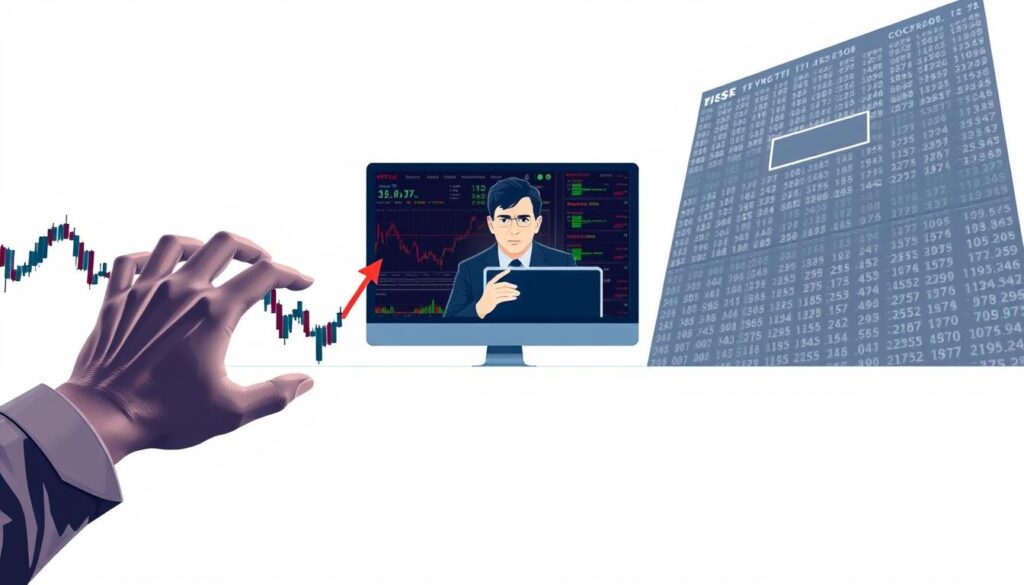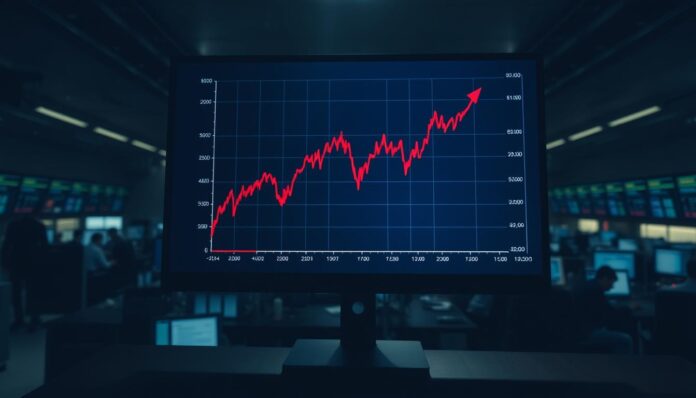Slippage in trading refers to the difference between the expected price of a trade and the actual price at execution. This slippage definition applies to all markets, from stocks to cryptocurrencies. When you place an order, slippage meaning can be seen as the gap between what you anticipated and what happens when the trade is processed.
Understanding slippage is key for traders because it directly impacts profits and losses. Whether you’re a beginner or seasoned investor, knowing how slippage works helps manage risks better. The concept is simple: prices move quickly, and sometimes your order fills at a different price than quoted.
Key Takeaways
- Slippage measures the gap between expected and actual trade execution prices.
- It occurs in all markets, including stocks, forex, and cryptocurrencies.
- Traders must account for slippage to avoid unexpected losses.
- Slippage definition focuses on price discrepancies during order execution.
- Learning about slippage meaning improves risk management strategies.
Understanding Slippage: A Brief Explanation
At its core, slippage refers to the difference between the expected price of a trade and the actual price at execution. Let’s break down the slippage definition using real-world scenarios. Imagine placing a market order for a stock at $100. If the trade executes at $102, you’ve just experienced slippage of $2. This gap matters because it alters profits and losses unexpectedly.
Definition of Slippage
Slippage occurs most often during fast-moving markets or low-liquidity conditions. For example, during major news events, prices can shift rapidly, leaving traders with results different from their initial target. The slippage definition also includes both favorable and unfavorable outcomes—though traders usually focus on the negative impact.
Why It Matters in Trading
“Even a $1 slippage per trade can wipe out profits over time.” – Professional Trader, MarketWatch
Understanding the impact of slippage reveals its hidden costs. Consider this:
- Small gaps add up: A 0.5% slippage on every trade can cut annual returns by 5-10%.
- Emotional strain: Unpredictable losses breed frustration, leading to impulsive decisions.
Whether trading stocks, forex, or cryptocurrencies, slippage isn’t just a technical term—it’s a silent profit killer. By grasping its mechanics now, traders can prepare strategies to mitigate its effects later.
Types of Slippage in Trading
Slippage meaning varies depending on market conditions, but knowing its three main types helps traders adapt strategies. Let’s break down how each form of slippage can work with or against your trades.
“The impact of slippage hinges on recognizing its type early.” – Trading Analyst Report
Positive Slippage
Positive slippage occurs when orders execute at a better price than requested. For example, placing a limit order to buy a stock at $50 might fill at $48 due to falling prices. This type benefits buyers but disadvantages sellers. Traders in fast-moving markets like forex often encounter this during sudden dips.
Negative Slippage
Negative slippage happens when execution prices move against you. Suppose you set a sell order at $100, but a breaking news event drives the price up—your order might execute at $98, reducing profit. This type has a direct impact of slippage on trades, often causing losses during volatile periods.
Zero Slippage
Zero slippage means orders fill at the exact price requested. This occurs most often in highly liquid markets like major stock indices or forex pairs during peak trading hours. While rare in low-liquidity assets like obscure stocks, brokers may advertise “zero slippage” on platforms with tight spreads.
Causes of Slippage
Slippage arises from specific triggers in markets like forex and stock trading. Let’s break down how these factors create gaps between expected and executed prices.
Market Volatility
Sudden price swings during high-impact events drive slippage. In slippage in forex trading, currency pairs like EUR/USD spike during central bank rate decisions, leaving orders unmatched at unfavorable levels. Stock markets face similar issues: Apple’s earnings report, for instance, can trigger rapid moves, causing slippage in stock trading.
Order Types
- Market orders execute instantly but risk slippage in fast-moving markets.
- Limit orders avoid overpayment but may miss fills entirely during volatility.
Execution Speed
Technology gaps worsen delays. Slow server responses or poor internet connections slow order processing. Brokers with advanced systems, like Interactive Brokers or TD Ameritrade, minimize this lag, reducing slippage risks.
“Speed matters most when markets shift in milliseconds,”
highlighting how infrastructure choices directly impact slippage frequency.
These factors interplay, making slippage inevitable in both slippage in forex trading and stock trading. Traders must adapt strategies to navigate these challenges.
How Slippage Affects Traders
Slippage isn’t just a technical term—it shapes real outcomes. For traders, the impact of slippage can shift strategies, profits, and even decision-making. Let’s break down its dual effects: financial and psychological.
Consider leveraged stock trading. Even small price gaps from slippage multiply losses when amplified by borrowed capital. For example:
- A $100 trade with 5% slippage loses $5 instantly.
- Over 100 trades, consistent 1% slippage costs 100% of initial capital.
Emotionally, slippage creates stress. Traders may panic, chase losses, or abandon plans. A 2023 study found 68% of active traders report frustration after unexpected slippage in volatile markets like crypto or stocks. Yet, emotional reactions often lead to worse choices.
| Reaction | Outcome |
|---|---|
| Panic selling | Increases losses |
| Adapting strategies | Reduces future risks |
Slippage in stock trading isn’t just math—it’s human. Awareness turns hidden costs into manageable challenges. Track gaps between expected and actual prices. Over time, this data reveals patterns to improve entry/exit timing and broker choices. Remember: slippage exists in every market, but its impact depends on how you respond.
Measuring Slippage
Quantifying slippage transforms abstract risks into actionable data. By tracking the impact of slippage, traders gain clarity on how market conditions affect execution. This section breaks down practical steps to measure and analyze this critical metric.
Slippage in trading refers to the difference between the expected price of a trade and the actual price at which the trade is executed.
Building on this definition, here’s how to translate theory into practice:
Calculation Methods
- Price Gap Method: Subtract execution price from the entry price (EP – AP)
- Percentage Analysis: [(Expected Price – Actual Price)/Expected Price] × 100
- Market-Specific Adjustments: Crypto traders often face higher slippage than traditional markets due to volatility
These methods reveal whether slippage vs spread costs are normal or need strategy adjustments.
Tools for Measuring Slippage
Modern platforms simplify tracking. For example, crypto CFD platforms often include real-time slippage analytics. Popular options include:
- MetaTrader 5’s TradeJournal feature
- TradingView’s historical price charts
- Broker-provided execution reports
Regular analysis helps traders adapt—turning data into better decision-making.
Preventing Slippage
Proactive steps can significantly reduce slippage risks. Here’s how traders can how to avoid slippage through strategic planning and tool selection.

Choosing the Right Broker
Broker selection impacts slippage in forex trading. Look for platforms with:
- ECN or STP execution models for faster order routing
- Servers in major financial hubs (e.g., London, New York) to cut latency
- Transparent reports on average slippage rates and execution success rates
Compare brokers using reviews from forums like Forex Factory or Myfxbook to identify reliable options.
Utilizing Limit Orders
Limit orders act as safeguards during volatile markets. For example:
- Set a limit order at your target price to lock in entries
- Pair with stop-loss orders to cap losses during sudden price gaps
“Limit orders are my first defense against slippage during news events,” says a 10-year forex trader.
Test strategies on a demo account before live trading to master timing and placement. Small adjustments here can make a big difference in reducing slippage during high-impact moments.
Managing Slippage in Your Trading Strategy
Slippage isn’t always preventable, but you can adapt your strategy to handle it effectively. Start by accepting that some slippage is inevitable—this mindset shift helps avoid frustration and poor decisions. Proactive adjustments ensure it doesn’t derail your goals.
Setting Realistic Expectations
Backtesting must include impact of slippage to reflect real-world conditions. Test strategies with added slippage buffers, like 0.5%–1% per trade. Avoid over-optimistic models that ignore this reality. Reducing slippage starts with acknowledging its presence in every market.
Adjusting Risk Management Techniques
Refine your approach with these steps:
- Adjust stop-loss placement to account for slippage. For example, widen stops by 10–15% to absorb unexpected gaps.
- Scale position sizes down. Use smaller lots to limit losses when slippage occurs.
- Modify entry triggers. Delay orders by a few ticks or use trailing stops to offset delays.
| Technique | Goal | Example |
|---|---|---|
| Slippage buffers in backtests | Prevent over-optimism | Add 0.5% slippage to each trade |
| Dynamic stop-loss widening | Protect capital | Use 20% extra buffer in volatile markets |
“Slippage isn’t a failure—it’s a cost to anticipate and plan for.”
Focus on how to avoid slippage through strategy tweaks rather than aiming for perfection. Small, consistent adjustments to risk parameters build resilience against its effects.
The Role of Liquidity in Slippage
Liquidity is the lifeblood of smooth trading. Markets with high liquidity allow orders to execute quickly, reducing slippage in trading. Low liquidity creates gaps between expected and actual prices, impacting outcomes in both slippage in forex trading and slippage in stock trading.
What Is Liquidity?
Liquidity measures how easily assets can be bought or sold without affecting their price. Think of it like a busy highway: more traders mean smoother transactions. For example:
- High liquidity markets: EUR/USD forex pairs, tech giants like Apple’s stock
- Low liquidity markets: Rare stocks, less-traded currency pairs
How Liquidity Influences Slippage
In slippage in stock trading, small-cap stocks often face larger gaps because fewer buyers/sellers exist. During quiet trading hours, slippage in forex trading spikes too. Here’s why:
- Thin order books create price jumps when large orders hit the market
- Volatility amplifies gaps in less liquid assets
What is Slippage in Trading becomes clearer when analyzing liquidity. Traders in forex markets often see tighter spreads during London/New York overlap hours when liquidity peaks. Meanwhile, small-cap stocks may experience slippage even in calm markets due to low volume.
“Liquidity isn’t just a number—it’s the difference between expected and actual execution.” — Market Analyst, BIS Research
Monitoring liquidity levels helps traders anticipate slippage risks. Tools like order flow analysis or volume charts provide real-time insights to navigate high or low liquidity periods effectively.
Common Myths About Slippage
Traders often misinterpret slippage meaning due to myths that spread through online forums. Let’s clear up confusion and focus on facts.

Misunderstandings in the Trading Community
Here are three myths to question:
- Myth 1: Slippage always costs money
- Myth 2: Slippage vs spread are the same
- Myth 3: Brokers intentionally cause slippage
The Facts Behind Slippage
Slippage isn’t inherently bad. Positive slippage can boost profits when prices move in your favor. Meanwhile, What is Slippage in Trading involves price gaps during execution—not the fixed cost of a spread. Spreads are fixed costs charged by brokers, while slippage depends on market conditions. Brokers don’t control slippage; it arises from liquidity gaps or sudden price jumps. For example, during news events, orders may fill at unexpected prices due to fast-moving markets, not malice.
Slippage in Cryptocurrency vs. Traditional Markets
Slippage in cryptocurrency trading differs significantly from traditional markets due to structural and operational contrasts. These differences shape how traders manage risks and outcomes.
Comparing the Two Markets
Key distinctions include:
- Traditional markets operate on fixed schedules, reducing unexpected slippage spikes during off-hours.
- Crypto markets run 24/7, but liquidity pools fragment across decentralized exchanges, raising volatility risks.
- Traditional exchanges use centralized order books; crypto relies on decentralized ledgers, slowing execution speeds.
Unique Challenges in Crypto Trading
Crypto’s decentralized nature creates hurdles like:
- Blockchain delays: Transaction confirmations can lag, causing price gaps between order placement and execution.
- Exchange bottlenecks: During price swings, platforms like Binance or Coinbase may slow order processing, worsening slippage.
- Thin markets: Low trading volumes for altcoins amplify slippage when large orders hit illiquid pairs.
Reducing slippage requires adapting strategies:
- Choose exchanges with high trading volumes to ensure better liquidity.
- Use limit orders during peak trading hours when prices stabilize.
- Monitor blockchain congestion to avoid delays in trade execution.
Staying informed about these factors helps crypto traders minimize slippage’s impact on profits.
Conclusion: Navigating Slippage Effectively
Slippage is a natural part of trading, but understanding how it works helps reduce its effects. This section wraps up key takeaways to help you manage it better.
Summary of Key Points
What is slippage in trading involves price differences between expected and actual execution. Causes include market swings and slow execution. To how to avoid slippage, use limit orders and pick brokers with fast processing. Tools like calculators show its impact of slippage on profits. Adjusting strategies based on these insights helps traders stay ahead.
Final Thoughts on Slippage in Trading
Slippage can’t be fully stopped, but smart choices cut its effects. Focus on realistic goals and tools that track its impact. By mastering these steps, traders build strategies that turn challenges into growth opportunities. Staying informed and proactive leads to stronger outcomes over time.

